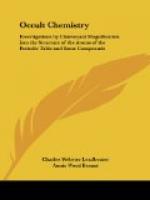the funnel is widened by the arrangement of its contents, three spheres
forming its first ring, as compared with the units in beryllium and
calcium, and the pairs in strontium and molybdenum. Two of these spheres
are identical in their contents—two quintets (7 f), a quintet (7 j),
and two quintets (7 e), e and f being to each other as object and
image. The remaining sphere (7 b) is identical with the highest in the
calcium funnel. The remaining two spheres, one below the other, are
identical with the corresponding two spheres in calcium. The central globe,
as regards its external segments, is again identical with that of calcium,
but in the internal segments a six-atomed triangle (7 k) is substituted
for the calcium four-atomed one (7 e).
CHROMIUM: 4 funnels of 210 atoms 840
Central
globe 96
-----
Total
936
-----
Atomic
weight 51.74
Number
weight 936/18 52.00
MOLYBDENUM (Plate VIII, 6) very closely resembles
strontium, differing from
it only in the composition of the highest pair of
spheres in the funnels
and in the presence of a little sphere, containing
two atoms only, in the
middle of the central globe. The topmost spheres
contain no less than eight
subsidiary spheres within each; the highest of these
(7 e) has four atoms
in it; the next three have four, seven and four (7
e g e),
respectively; the next three are all septets (7 g),
and the last has
four—making in all for these two spheres
88 atoms, as against the 48 in
corresponding spheres of strontium, making a difference
of 160 in the four
funnels.
MOLYBDENUM: 4 funnels of 408 atoms 1632
Central
globe 98
-----
Total
1730
-----
Atomic
weight 95.26
Number
weight 1730/18 96.11
II a.—This group contains magnesium, zinc,
cadmium, and mercury, with an
empty disk between cadmium and mercury; we did not
examine mercury. All are
diatomic, diamagnetic and positive; the corresponding
group consists of
sulphur, selenium and tellurium, also all diatomic
and diamagnetic, but
negative. The same characteristics of four funnels
opening on the faces of
a tetrahedron are found in all, but magnesium and
sulphur have no central
globe, and in cadmium and tellurium the globe has
become a cross.
[Illustration: PLATE IX.]
MAGNESIUM (Plate IX, 1) introduces us to a new arrangement: each group of three ovoids forms a ring, and the three rings are within a funnel; at first glance, there are three bodies in the funnel; on examination each of these is seen to consist of three, with other bodies, spheres, again within them. Apart from this, the composition is simple enough, all the ovoids being alike, and composed of a triplet, a septet and a duad.




